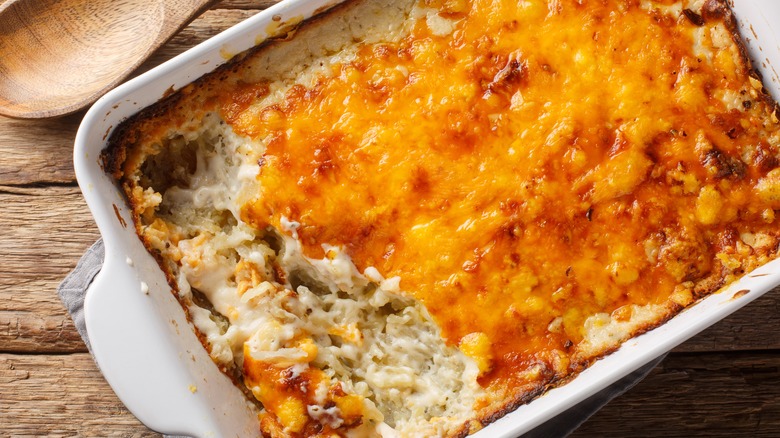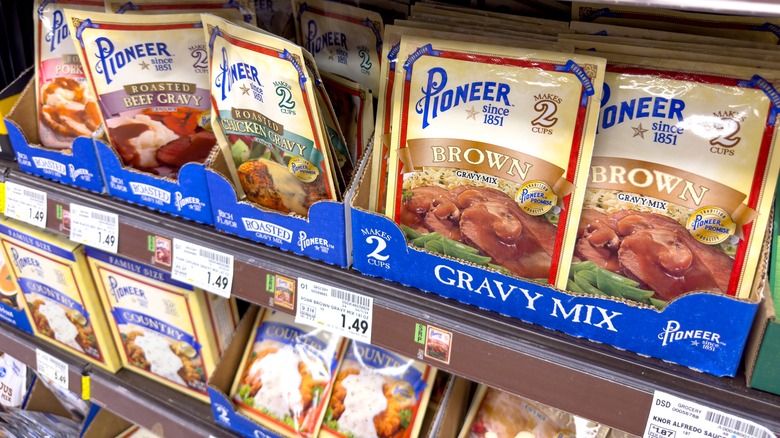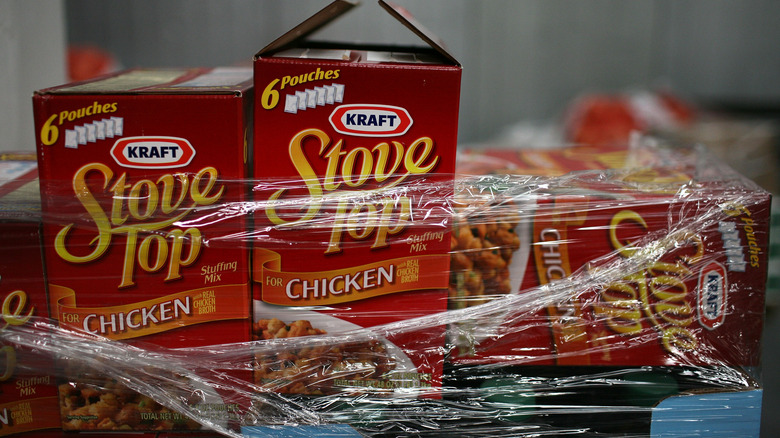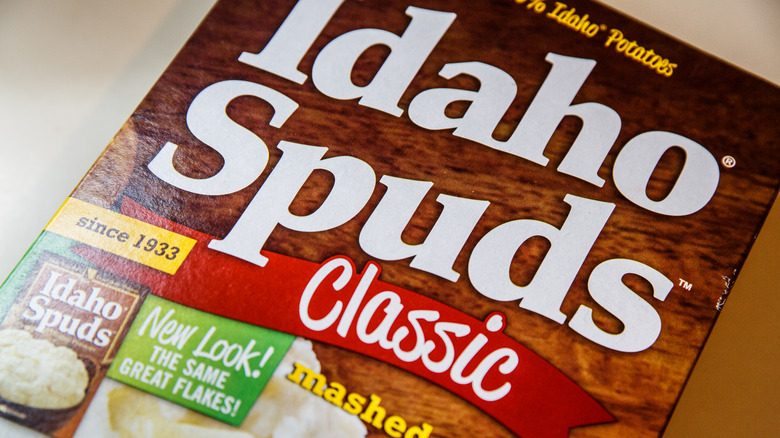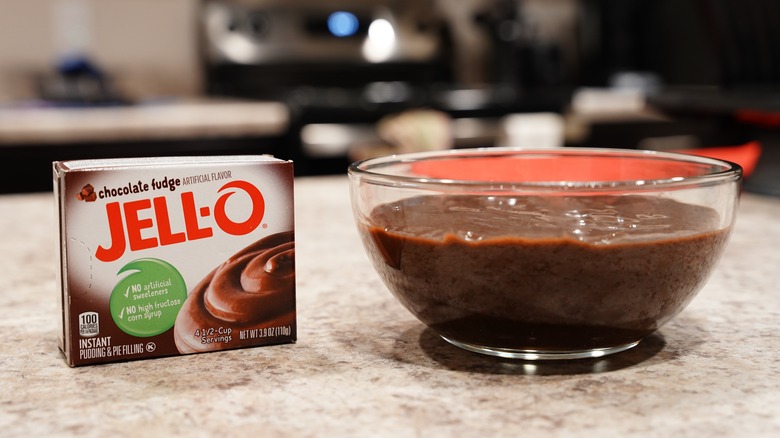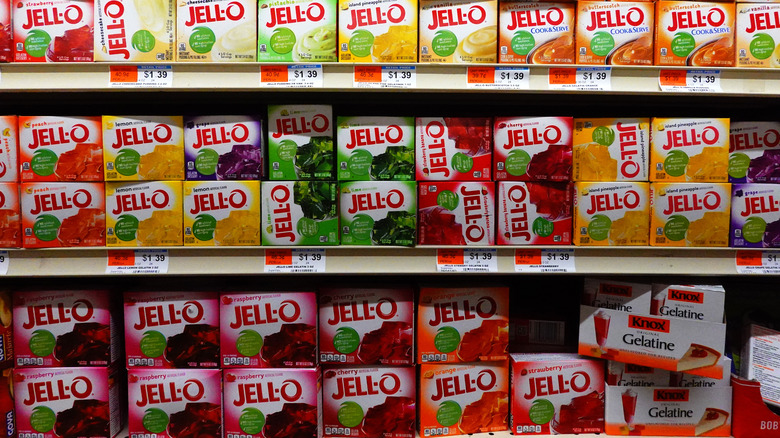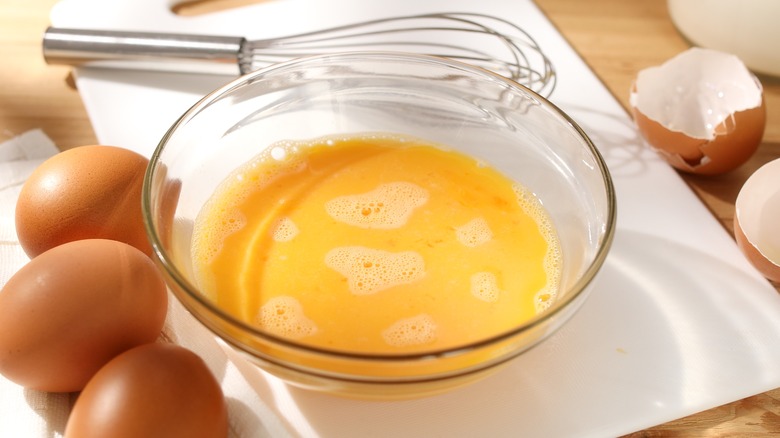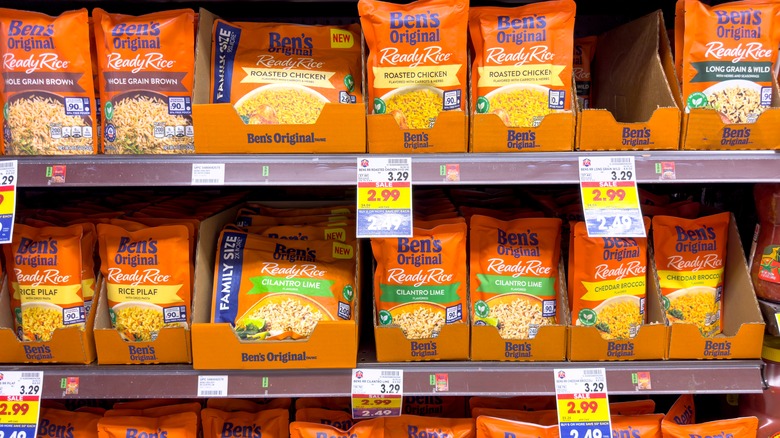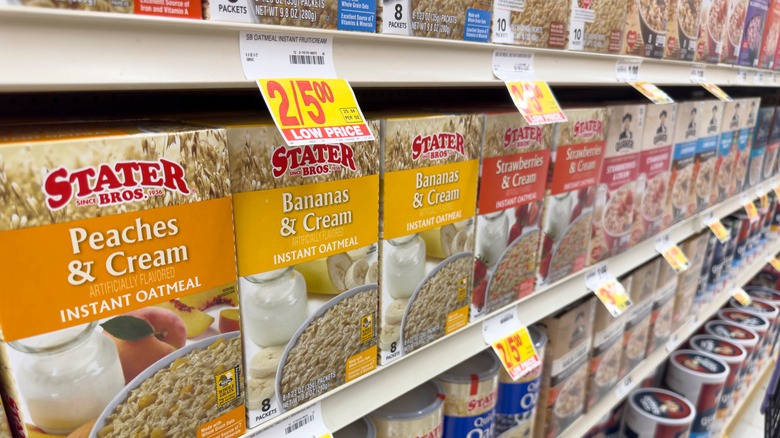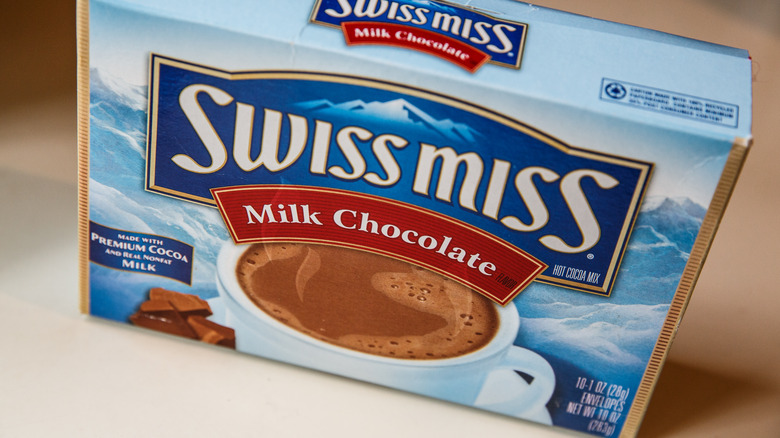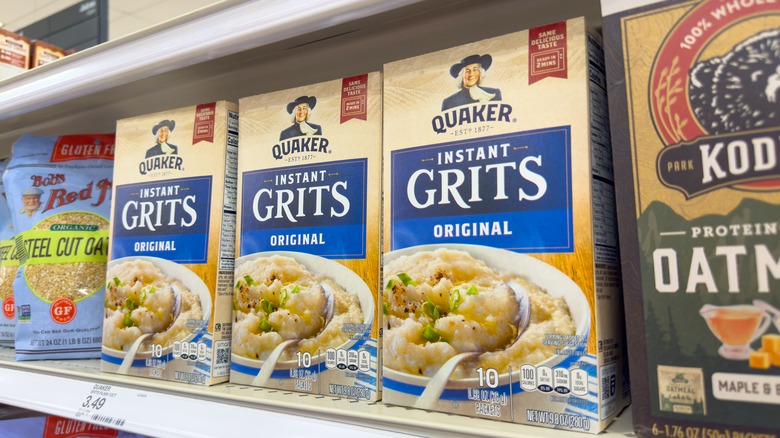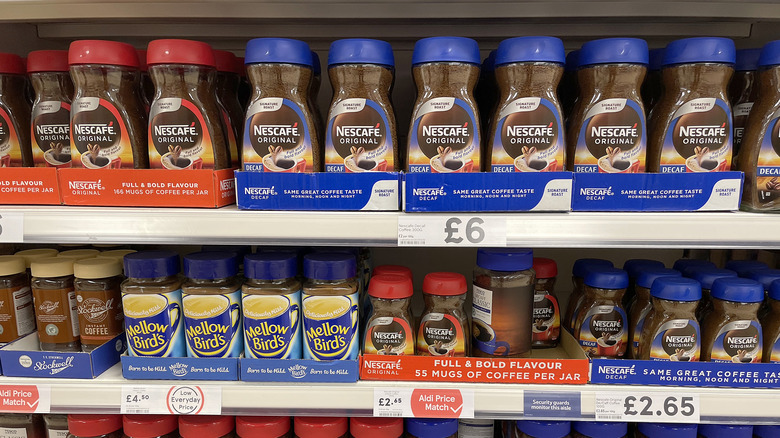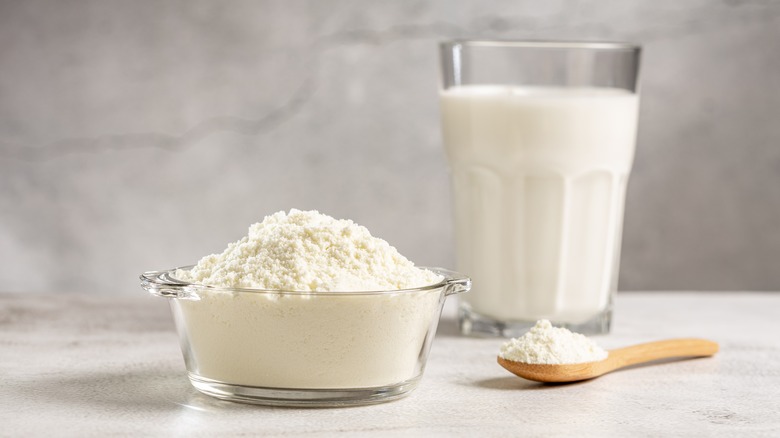Times When Using An 'Instant' Version Of A Food Is Just As Good
While instant food may feel like a relatively new phenomenon, crafted to cater to the ever-busying modern lifestyle, versions of instant food have actually been around for quite a while. Think, for example, of long-lasting, portable foods like pemmican, which Indigenous populations used for easy, calorie-rich meals on the go. However, while the more recognizable instant foods you might be familiar with today received a substantial amount of love in the mid-1900s, marketed to busy housewives as a convenient option, now, some home cooks turn up their noses at instant foods. They're deemed ultra-processed and lower quality than their from-scratch counterparts.
While no one's arguing that most instant food is ultra-processed, don't make the mistake of overlooking the many uses for instant foods in your life, and the times and situations wherein an instant version of a food can be just as good as the real deal. Here are a few examples of when that might be the case, and what you'll need to keep in mind to get the most out of some favorited instant foods.
Condensed soup in casseroles and similar dishes
First introduced to the world in 1897, condensed soup is basically just soup that's been boiled down to such a degree that the majority of the water content has evaporated. The manufacturer adds some extra thickeners and flavorings, and the result is a cheap, readily available, long-lasting product that only requires a bit of water or milk, and a few minutes on the stovetop to produce what some claim is a perfectly fine bowl of soup.
Unfortunately, condensed soup can't hold a candle to a homemade, from-scratch soup that started with a homemade stock and that's been simmering for hours. However, condensed soup does work wonders in casseroles and similar dishes, providing both a thicker consistency and a large amount of flavor. You can't have a classic green bean casserole or hot dish without condensed soup.
Some will say if you want to modify one of these recipes by using condensed soup at home, simply add broth and milk to a roux and making a very thick gravy-like substance. However, the extra effort isn't worth it for many home cooks. The canned variety is faster and cheaper, and, while, yes, ultra-processed, doesn't really often contain that much in the way of sketchy ingredients.
Gravy mix can increase the quantity of homemade gravy
Whether you're making turkey gravy to go with your Thanksgiving feast, mushroom gravy to add to a pot roast, or sausage gravy to smother your breakfast biscuits, you can either labor over a pan of drippings, stirring in milk and flour until you have a homemade gravy, or you can simply add water to a packet of powder and let it boil until it's done. The former option provides more flavor and, often, a better texture, but there's one instance where you might want to reach for that gravy mix in the back of the pantry: If you're running low on the homemade stuff.
Many of the same ingredients that you might use to make gravy mix taste better are also the same ingredients you would use anyway for homemade gravy, such as aromatic herbs and pan drippings, and packaged gravy can also be used to help thicken runny homemade gravy, in a pinch. So, the next time you realize you just don't have enough homemade gravy to go around, break out a pack of gravy and slowly incorporate it into the homemade gravy, adding extra water, broth, or milk to maintain your desired consistency, and watch the quantity increase.
Use stuffing mix in casseroles and as a binding agent
Making homemade stuffing (or dressing, depending on what you like to call it) requires you to have some cubed bread on hand, as well as usually an hour-plus of labor and cooking. Sure, the results are spectacular, but you don't always have that kind of time. Instant stuffing mix only requires a few minutes on the stove and water or broth; in contrast, instant stuffing mix, while tasty, leaves a lot to be desired, especially in the texture department.
However, while you might not want to swap out your family stuffing recipe for the boxed stuff over the holidays, keep some on hand anyway for use in casseroles (combine it with cheese, condensed soup, and shredded chicken for a super-easy dinner that requires minimal prep and oven time) or for use as a binding agent in dishes like meatloaf. Especially for meatloaf, the texture of boxed stuffing actually works better than the texture of homemade stuffing.
Instant mashed potatoes are a thickening agent
Potato flakes are made by taking the less-desirable potatoes in a harvest and cooking them, turning them into a mash, dehydrating the mash, and then chopping up all the dehydrated mash into flakes. While instant mashed potatoes are typically pretty bland and definitely not rich and creamy, like the real deal, they do still have their place in your pantry. Instant mashed potatoes make for an excellent thickening agent, particularly in a few dishes.
Trying to bulk up some watery potato soup? Add potato flakes to soak up some of that moisture without altering your soup's flavor profile. This trick doesn't only apply to potato soup, either. You can thicken many varieties of soup with instant potatoes, as the potatoes' blandness won't clash with many soup recipes. Want some gravy to go along with your pot roast, but don't have any flour or cornstarch? Add a some potato flakes to your drippings. Trying to thicken a too-thin pasta sauce? Again, add the potato flakes.
Instant pudding mix fixes any pudding needs
There are a few instant foods that are, in general, just superior to their homemade counterpart in every way. Such is the case with instant pudding mix. Have you ever tried to make pudding from scratch? While, yes, it requires minimal ingredients and time, the texture and flavor are just not as reliable when you compare the results to what you'd get from a box of pudding mix. Additionally, some homemade pudding recipes call for adding raw eggs, and since the eggs aren't exposed to a high level of heat for very long, it calls food safety into question.
In contrast, instant pudding comes in a variety of flavors, only requires you to pour in some milk, and then is ready to eat in minutes. You can eat it on its own or use it in desserts like trifles. You can also add it to baked goods for a moister texture or add it to whipped cream as a stabilizer. Instant pudding mix is a great product and, if you don't want to, there's no need to make from-scratch pudding ever again. It's even perfect for those tasty dirt cups.
Instant Jell-O can be used for every Jello occasion
Right next to the instant pudding, you'll find the near-identical boxes of Jell-O. This instant gelatin mix makes making Jell-O super-easy, to the point that most home cooks won't even attempt making something similar at home from scratch, unless they're trying to avoid the dye and additives that can sometimes be found in boxed Jell-O, or if they're trying to make vegan Jell-O.
This is all because the process of making Jell-O from scratch starts with making gelatin (unless you use another instant product, gelatin powder). Manufacturers make gelatin by processing animal bones, skin, and other parts; this includes curing, disintegrating, washing, cooking, filtering, evaporating, drying, and then grinding all these parts until you get a gelatin powder. While some do undertake this process at home using cow or deer bones, it's not exactly a fun process.
So, whether you're making just Jell-O, Jell-O shots, a vintage Jell-O salad, or a poke cake, go for the instant option. There's no need to go ask your local butcher for some bones. Just grab a box of Jell-O.
Powdered eggs in baking
When eggs are dehydrated and transformed into powder, you get powdered eggs. Powdered eggs offer a long shelf life and the protein of regular eggs, and they're popular with end-of-the-world preppers or for those who use dehydrated foods while camping or enjoying some other type of recreation that requires them to cook and eat off the grid. All you have to do is rehydrate the eggs with water and then cook the eggs like a normal freshly cracked egg. However, the reviews for powdered eggs note a pretty bad taste, smell, and texture.
The one place where everyone can seem to agree that powdered eggs have a place, though? In your baking projects. You can use instant powdered eggs in meringues, as a stabilizing agent. You can use them in cookie doughs or brownie batters where you might want to enjoy some of the raw dough or batter, without risking salmonella poisoning. If you do add powdered eggs to a baking project, just add the powder to the rest of your dry ingredients, rather than reconstituting the eggs and adding them to your wet ingredients.
Instant ramen's great if you're in a time crunch
Instant ramen noodles came on the scene in the 1950s and the world has never been the same. Whether you're a broke college kid or love the comforting nature of ramen, instant ramen provides a quick, easy, delicious meal for a less than $0.50, and, whether you're tossing a Styrofoam cup in the microwave or heating some water on the stovetop, the process is simple. However, for anyone who frequents their local ramen shop, the stuff you make at home just isn't the same.
You could make homemade ramen, but by the time you prepare all the normal accompaniments, plus actually cook the soup, you have nearly an hour of work invested. If you have an hour, by all means, move ahead with the homemade ramen. However, if you're in a time crunch, opt for the instant ramen — just dress it up a bit. For no extra cooking, chopping, or other prep, add some pre-shredded carrots or cabbage, a drizzle of sesame oil, dried shiitake mushrooms, Japanese 7 spice seasoning, kimchi, or chili flakes. You can also add in any leftovers you have on hand, or our favorite addition, bacon bits.
Try instant rice in broader dishes
If you've ever opened a recipe for a quick meal, realized it calls for cooked rice, panicked because you have no leftover cooked rice, and subsequently added at least a half an hour to your cooking time, standing over a boiling pot of rice waiting for it to cook, stop. Instant rice is to the rescue, a perfect, time-saving instant ingredient that works well in larger dishes, even if it's not as good as regular rice, texture-wise. Depending on the instant rice you buy, the packaging may instruct you to microwave the rice, or cook it in boiling water, but obviously the microwave option is faster.
Use instant rice in larger dishes that aren't quite so reliant on rice's texture. For example, you might not want to use instant rice as a side dish on its own, or for fried rice, but it works well in soups, stews, or casseroles. You can also use rice as a binding ingredient in meatloaf.
Instant oatmeal with extra add-ins and toppings is just the same
Like many instant products, instant oatmeal really fails to live up to the non-instant variety in the texture department. However, instant oatmeal is really a godsend if you're short on time or don't want to spend time at the stove. Just boil some water in the microwave and you're good to go.
The good news? Instant oatmeal can be just as good a breakfast, when you're in a time crunch, if you jazz it up a bit. Consider focusing on texture first (because some flavored instant oatmeal tastes perfectly fine as is!). Add dried fruits, nuts, and seeds for a little bit of crunch and a bit more chew. If you prefer a creamier texture and need to add a thickener to your instant oatmeal (maybe you got a little overzealous when you were adding in your boiling water), consider stirring in some Greek yogurt or peanut butter, or even some protein powder.
Experiment with instant hot chocolate in unexpected places
There's nothing quite as decadent as rich, creamy hot chocolate made with actual chopped chocolate and actual milk, none of that powdered stuff. However, don't dismiss instant hot chocolate completely. First, you can get it pretty close to as good as homemade if you dress it up with add-ins and extras, such as Nutella, caramel, or eggnog. Options like these can not only add more flavor to a bland, runny, mix-based hot chocolate, but also make the hot chocolate creamier.
Also consider using instant hot chocolate in other, unexpected places, too. You can use instant hot chocolate in your baking projects, either in your cake mix or in your homemade icing. You can add it to pancake or waffle mix. Toss popcorn or roasted nuts in it. You've heard of adding coffee to your hot chocolate, but what about adding hot chocolate mix to your coffee? Wherever you might like a little extra chocolate-y flavor, consider adding instant hot chocolate mix.
Instant grits if you're not eating them plain
While many a Southerner may balk at the idea of using instant grits, there are plenty of times that using instant grits is just as good as using stone-ground grits. When you're short on time, instant grits are great, even if they might not be as tasty or have the same texture as regular grits. To fix these issues, all you need to do is not eat the grits plain and to go a little bit beyond just adding butter to your grits.
For example, adding plenty of cheese can help both taste and texture. Topping them with a generous portion of food that offers plenty of flavor and texture all on its own is a good idea, too; try a heaping spoonful of jambalaya or gumbo, or a sauce-y serving of shredded barbecue. A poached egg can add yolk-y goodness. You can use instant grits in casseroles, too.
Instant coffee in baking
Some baking recipes, particularly if you're baking something very rich and chocolate-y, will call for a small serving of espresso or coffee. Don't run to the coffee pot or espresso machine, though. Instead, reach for your instant coffee. While, sure, instant coffee's taste can cause you to shy away from using it as your morning cup of joe, instant coffee is pretty perfect for baking.
In small amounts, instant coffee doesn't really add any coffee flavor to your baked good, but it does enhance the flavor of your chocolate. Coffee's bitter notes provide balance and nuance, making for an overall richer, deeper chocolate experience. If, though, you do want a coffee flavor, just add more instant coffee. Because instant coffee requires very little water to rehydrate and provide those flavors, you can also add it to your baked item without throwing off the wet-to-dry ingredients ratio, which could happen if you just add straight, brewed coffee.
Powdered milk in baking
Much like instant coffee, powdered milk might not taste exactly like (or as good as) the regular stuff, but it does come in very handy when baking. Powdered milk, which is basically just milk that's had all the liquid removed, can greatly impact baked goods' texture and stability.
For example, if you're baking bread, powdered milk can make your yeast breads rise a little higher and come out a little softer. It even positively impacts the bread's appearance, giving it a darker hue. If you're making cookies, adding powdered milk to your dry ingredients can make the cookies a little chewier on the inside and crustier on the outside.
Much like instant coffee or powdered eggs, powdered milk should be added to your baked item's batter or dough at the same time that you add your dry ingredients. You don't need to reconstitute the milk. Just use the powder as is, so it doesn't interfere with your wet-to-dry ingredients ratio.

